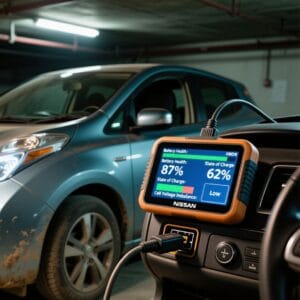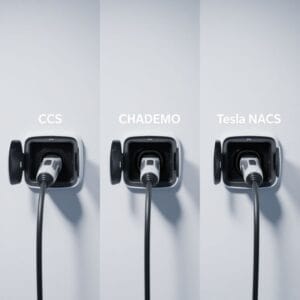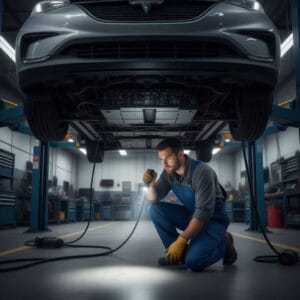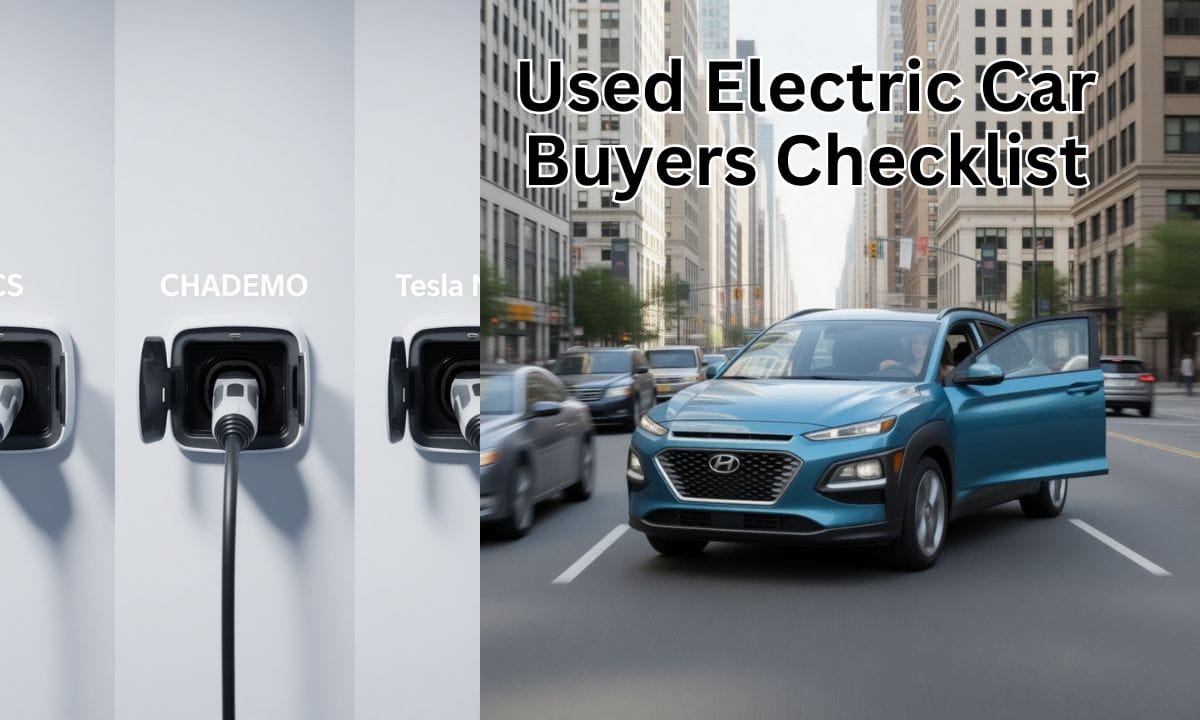Used Electric Car Buyers Checklist: Your Complete Guide to a Smart, Stress-Free Purchase
The electric vehicle (EV) revolution isn’t coming—it’s already here. And if you think you’ve missed the boat, think again. Today, the used electric car market is booming with well-maintained, affordable, and surprisingly advanced models that deliver exceptional value. But unlike buying a secondhand gasoline car, shopping for a pre-owned EV requires a different mindset, specific knowledge, and a sharp eye for battery health, charging capabilities, and software features.
This Used Electric Car Buyers Checklist is your roadmap to navigating this exciting yet nuanced market. Whether you’re eyeing a 2017 Nissan Leaf for city commuting or a gently used Tesla Model 3 for weekend road trips, this guide arms you with everything you need—from defining your real-world range needs to decoding battery reports and avoiding hidden pitfalls.
We’ll walk you through each critical step, backed by expert insights, real-world data, and links to essential resources on your journey. By the end, you’ll feel confident, informed, and ready to drive home in a clean, cost-effective, and future-ready vehicle—without overpaying or overlooking deal-breakers.
And don’t worry—we’ll keep it practical, jargon-free, and grounded in what actually matters to you, the buyer. Let’s plug in and get started.
Why Buying a Used Electric Car Makes More Sense Than Ever

Gone are the days when “used EV” meant “compromise.” Thanks to rapid advancements in battery technology, plummeting resale values of early models, and growing charging infrastructure, purchasing a pre-owned electric car is now one of the smartest automotive decisions you can make—especially if you’re budget-conscious or environmentally aware.
First, consider depreciation. New EVs can lose 40–60% of their value in the first three years—far steeper than gas cars. That steep drop creates golden opportunities. For example, a 2020 Chevrolet Bolt originally priced at $37,000 might now sell for under $18,000 with over 100,000 miles, yet it still offers a usable 200+ miles of real-world range. That’s incredible value per mile.
Second, lower running costs remain a massive advantage. Even used EVs cost 70–80% less to “fuel” than gas equivalents. Maintenance is simpler too—no oil changes, spark plugs, or timing belts. According to the U.S. Department of Energy, EV owners save an average of $800–$1,000 annually on fuel and maintenance. Over five years, that’s $5,000 back in your pocket.
Third, today’s used EVs are far more capable than early adopters’ models. A 2019–2022 Nissan Leaf, for instance, offers 150–226 miles of range, DC fast charging, and modern safety tech—features absent in 2013 versions. And as charging networks like Electrify America and Tesla’s Supercharger open to non-Tesla vehicles, range anxiety is fading fast.
For deeper insights, explore our guide on electric car buying guide and learn how ownership costs stack up in electric car vs gas car .
Understanding the Basics: How EVs Differ from Gas-Powered Vehicles

Before you start test-driving, it’s crucial to grasp how electric vehicles fundamentally differ from internal combustion engine (ICE) cars—not just in powertrain, but in ownership experience.
At the core, EVs replace the engine, transmission, and fuel system with a battery pack, electric motor, and power electronics. This shift simplifies mechanics but introduces new considerations: battery health, regenerative braking, charging speed, and software dependency. Unlike a gas car where “miles = mileage,” an EV’s condition hinges heavily on how the battery was treated—frequent fast charging, extreme temperatures, and deep discharges all accelerate degradation.
You’ll also notice driving dynamics are different. Instant torque means zippy acceleration from a stop. Regenerative braking lets you slow down by lifting off the accelerator—some EVs even offer “one-pedal driving,” which takes getting used to but boosts efficiency. Cabin noise is dramatically lower, making road and wind noise more apparent.
Additionally, software updates can add features or improve performance—something unheard of in traditional cars. Tesla pioneered this, but now brands like Ford, Hyundai, and BMW push over-the-air (OTA) updates to used models too.
Most importantly, refueling becomes “recharging,” which requires planning. While gas takes 5 minutes, even Level 2 home charging takes hours. But the trade-off? You “refuel” overnight while you sleep. For more on how EVs operate, see our detailed explanation: how do electric cars work .
Step 1: Define Your Needs and Budget Clearly
Jumping straight into browsing listings is a recipe for overwhelm—or regret. Start by asking: What do I actually need this car to do? Be brutally honest about your driving habits.
Consider Your Daily Driving Range
The EPA-rated range is a starting point—but real-world performance depends on climate, driving style, and terrain. If your daily commute is 30 miles round-trip, even a used Nissan Leaf with 100 miles of range is sufficient—with room to spare. But if you regularly take 150-mile trips, you’ll need a model with at least 200 miles of real-world range (like a Bolt, Kia Niro EV, or older Model 3).
Remember: cold weather can reduce range by 20–40%. If you live in Minnesota, prioritize EVs with heat pumps (e.g., Hyundai Kona, Tesla) over resistive heaters that drain the battery faster. Learn more in our guide on how electric cars work in cold weather .
Factor in Total Cost of Ownership (Not Just Upfront Price)
Your budget shouldn’t stop at the sticker price. Include:
- Home charger installation ($300–$1,200 for a Level 2 unit)
- Electricity costs (use the DOE’s eGallon tool )
- Insurance (some EVs cost more to insure due to expensive parts)
- Potential battery replacement (rare under 100,000 miles, but know the risk)
A $15,000 Leaf with a degraded battery may cost more long-term than a $22,000 Bolt with 90% battery health. Always calculate cost per mile over 5 years—not just the purchase price.
Step 2: Research the Right EV Model for Your Lifestyle
Not all EVs are created equal. Your ideal used EV depends on space, driving style, charging access, and tech preferences.
Compact vs. SUV vs. Luxury: Which Segment Fits You?
- Compact EVs (Nissan Leaf, Chevrolet Bolt, Mini Cooper SE): Ideal for city dwellers, solo commuters, or budget buyers. Affordable, efficient, and easy to park—but limited cargo space and rear legroom.
- Electric SUVs (Hyundai Kona EV, Kia Niro EV, Tesla Model Y): Best for families, pet owners, or those needing cargo flexibility. Higher seating position, more ground clearance, and better range in newer models.
- Luxury EVs (Tesla Model 3/S, BMW i4, Audi e-tron): Offer premium materials, advanced driver aids, and superior performance—but come with higher insurance and repair costs.
Visit our comparison of best SUV electric vehicles in India or explore compact SUVs car options for more insights.
Top Reliable Used EVs Under $30K (With Real-World Range Data)
Avoid early EVs with no DC fast charging (e.g., pre-2018 Leaf) unless you have Level 2 at home and never road-trip.
Step 3: Decode the Battery Health Report
If there’s one thing that separates a savvy used EV buyer from a regretful one, it’s understanding the battery. Unlike an engine that either runs or doesn’t, an EV battery degrades silently over time—and that degradation directly impacts your driving range, resale value, and long-term cost.
What Is Battery Degradation—and How Much Is Normal?
Battery degradation is the gradual loss of a battery’s ability to hold a full charge. It’s measured as State of Health (SOH)—a percentage comparing current capacity to the original. For example, a 2019 Nissan Leaf that originally held 40 kWh but now stores only 34 kWh has an SOH of 85%.
What’s acceptable?
- 0–3 years old: ≥90% SOH
- 3–6 years old: ≥80% SOH
- 6+ years old: ≥70% SOH (proceed with caution)
Batteries degrade faster under:
- Frequent DC fast charging
- Regular 100% charging or deep discharges
- Prolonged exposure to extreme heat or cold
A Bolt or Niro EV with 85% SOH at 50,000 miles is excellent. A 2015 Leaf at 70% SOH with 80,000 miles? Think twice.
For deeper insights on longevity, see our guide: how long do electric car batteries last .
Tools to Check EV Battery Condition (OBD2, Manufacturer Apps)
You don’t need to guess—you can verify. Most modern EVs provide battery health data through:
- OBD2 scanners (like the CarScanner ELM OBD2 app paired with a Bluetooth adapter)
- Manufacturer apps (e.g., Tesla app shows battery range; Hyundai’s Bluelink shows charging history)
- Third-party tools like EV Battery Health (for Teslas) or Leaf Spy (for Nissan)
Ask the seller to:
✅ Share a recent battery report
✅ Allow a plug-in diagnostic scan
✅ Confirm no battery-related error codes
Pro tip: If the seller refuses or says “the battery is fine,” walk away. Transparency is non-negotiable.
Also check the EV battery recall database via the NHTSA (National Highway Traffic Safety Administration) —especially for models like early Bolt EVs (recall due to fire risk) or certain Kia Niro EVs.
Step 4: Inspect the Charging Compatibility & Infrastructure
An EV is only as useful as its ability to refuel—and “refueling” means charging. Unlike gas pumps (which are universal), EV chargers vary by region, brand, and connector type.
Level 1 vs. Level 2 vs. DC Fast Charging: What Can the Car Handle?
- Level 1 (120V): Adds 3–5 miles per hour. Only practical for plug-in hybrids or very short commutes.
- Level 2 (240V): Adds 20–45 miles per hour. Essential for home or workplace charging.
- DC Fast Charging (480V+): Adds 100–200 miles in 15–30 minutes. Crucial for road trips.
Your checklist must include:
✔ Port type: CCS (most non-Tesla), Type 2 (Europe), CHAdeMO (older Nissan/Mitsubishi), or Tesla (now opening to others)
✔ Max DC charging speed: e.g., Bolt = 55 kW, Ioniq 5 = 350 kW
✔ Ultra-fast compatibility: Only newer models (2021+) support 150+ kW charging
A 2017 Leaf with CHAdeMO and 50 kW charging will feel painfully slow compared to a 2022 ID.4 with 135 kW CCS.
Learn more in our detailed breakdown: charging an electric car .
Are Chargers Available at Home, Work, and Along Your Routes?
Use tools like:
- PlugShare
- A Better Routeplanner (ABRP)
- Your local utility’s EV program
Ask yourself:
- Can I install a Level 2 charger at home? (Cost: $500–$1,200)
- Is there reliable public charging near work or frequently visited spots?
- Does the car’s native nav integrate with charger locations? (Tesla and newer Hyundais do)
If you live in an apartment without charging, prioritize models with longer range and fast-charging capability—and always carry a portable Level 1 cord as backup.
For UK buyers: explore how much to charge an electric car at Tesco and free charging options .
Step 5: Get a Pre-Purchase Inspection from an EV-Savvy Mechanic
Never skip this step. A standard mechanic may spot a worn tie rod—but they likely won’t detect a failing inverter, imbalanced battery cells, or degraded regenerative braking.
What to Look for in an EV-Specific Inspection
An EV-certified technician should check:
- High-voltage system integrity (no coolant leaks in liquid-cooled batteries)
- Motor and inverter performance
- 12V auxiliary battery health (often overlooked but critical for startup)
- Charging port condition (corrosion or bent pins can cause failures)
- Brake system (regen reduces wear, but pads can seize from disuse)
Cost? Typically $100–$200, but it could save you $5,000+ in hidden repairs.
Red Flags: Signs of Water Damage, Crash History, or Battery Swelling
Watch for:
- Musty odors or foggy headlights → flood damage
- Misaligned panels or paint overspray → poor accident repair
- Error messages like “Charging Limited” or “Power Reduced” → battery or BMS issues
- Uneven cell voltage (via OBD2 scan) → imminent battery failure
Always run a Carfax or AutoCheck report (US) or HPI Check (UK). Also, inspect the VIN on the dashboard, driver’s door jamb, and registration to ensure they match.
If the car was in a rear-end collision, the battery pack (usually under the floor) may be compromised—even if it “drives fine.”
Step 6: Understand Warranty Coverage and CPO Programs
Used EVs often come with transferrable warranties—especially on the battery and drive unit. Don’t assume it’s expired!
- Tesla: 8 years / 120,000–150,000 miles (varies by model)
- Hyundai/Kia: 10 years / 100,000 miles on battery
- Chevrolet: 8 years / 100,000 miles (Bolt EV)
- Volkswagen: 8 years / 100,000 miles
Certified Pre-Owned (CPO) EVs undergo rigorous inspections and often extend the battery warranty. They cost more upfront but offer peace of mind.
Critical: Verify warranty status yourself using the VIN on the manufacturer’s website—don’t rely on the seller’s word.
Also, check for open recalls at NHTSA.gov or your country’s equivalent (e.g., DVSA in the UK).
Step 7: Verify Maintenance History and Software Updates
EVs need less maintenance, but they still need care:
- Cabin air filter replacement
- Brake fluid (yes, EVs still use hydraulic brakes)
- Tire rotation (regen causes uneven wear)
- Software updates (can fix bugs or add features)
Ask for:
- Digital service records (via manufacturer app)
- Proof of battery coolant flushes (for liquid-cooled models)
- Last software version installed
A car stuck on 2021 software might miss critical battery management improvements rolled out in 2023.
For tips on upkeep, read our guide: electric car maintenance .
Step 8: Test Drive Like an EV Expert (Not Just a Regular Car)
A test drive for a used EV isn’t just about handling—it’s a diagnostic session in disguise. Unlike gas cars, where you listen for engine knocks or feel transmission shifts, EV test drives focus on battery behavior, regenerative braking, thermal management, and software responsiveness.
During your drive, actively simulate real-world conditions:
- Accelerate briskly (EVs deliver instant torque—ensure no power cutouts)
- Engage one-pedal driving (if available) to test regen smoothness
- Check cabin heat and AC performance (these heavily impact winter range)
- Monitor the real-time range estimate—does it drop linearly or plummet unexpectedly?
Crucially, watch for thermal warnings or “reduced performance” alerts—signs the battery is overheating or degraded. Also, note how the car behaves at low state of charge (<20%): some older EVs drastically limit power to protect the battery.
For a deeper dive, see our guide on how electric cars work in cold weather and what features drain an EV battery most .
💡 Pro Tip: Bring a Level 2 charger to the test drive. Plug in for 10 minutes and verify the car accepts a charge and displays accurate kW input. A car that refuses to charge or shows erratic behavior is a red flag.
Common Mistakes First-Time Used EV Buyers Make (And How to Avoid Them)

Even savvy car buyers stumble when entering the EV world. Here are the top 5 pitfalls—and how to sidestep them:
- Ignoring Battery Cooling Type
Older Leafs and early EVs use air cooling, which accelerates degradation in hot climates. Liquid-cooled batteries (in Bolt, Tesla, Hyundai, Kia) last far longer. Always check your checklist: “Battery Cooling System Type: ______”. - Assuming All Chargers Are Equal
A 2015 Nissan Leaf uses CHAdeMO, while modern EVs use CCS. Tesla’s NACS is becoming universal—but adapters aren’t always included. Verify: “Charging Port Type: ______” and “Adapter included: Yes / No”. - Overlooking 12V Battery Health
Yes, EVs still have a 12V auxiliary battery (for lights, infotainment, and booting the main system). If it’s dead, the car won’t start—even with a full high-voltage battery. Ask for it to be tested. - Skipping a Software Check
Outdated software can disable critical functions (e.g., battery preconditioning, regen braking). Ensure: “Latest software update installed: ✔️” - Not Verifying Recall Status
The 2017–2019 Chevrolet Bolt was under a fire-risk recall requiring battery replacement. Always check NHTSA.gov before buying.
For more, explore our article on hidden features of Tesla OS and EV battery health .
Where to Buy: Dealership vs. Private Seller vs. Online Platforms
Your purchase channel affects price, warranty, and peace of mind.
- Certified Pre-Owned (CPO) Dealerships
Pros: Full inspection, extended battery warranty, return policy
Cons: 10–20% markup
Best for: First-time EV buyers or those prioritizing security - Private Sellers
Pros: Lower prices, room to negotiate
Cons: No warranty, risk of hidden damage, no recall resolution
Best for: Tech-savvy buyers who can verify battery health - Online Platforms (Carvana, Vroom, Shift)
Pros: Convenience, 7-day return window
Cons: Limited EV inventory, often higher mileage
Tip: Only buy if they provide OBD2 battery reports and charging tests
⚠️ Warning: Avoid “too good to be true” deals on Facebook Marketplace or Craigslist. Many scammers list stolen or non-functional EVs. Always meet in person, inspect thoroughly, and verify VIN.
For trusted options, see our guide on where to buy an electric car .
Final Checklist: 10 Must-Ask Questions Before You Sign
Before handing over a deposit, ask these 10 critical questions:
- Can I see the full battery health report (SOH %)?
- Has the car ever been in a flood or rear-end collision?
- Is the high-voltage battery still under warranty?
- Do all charging cables and adapters come with the car?
- Has the car received all manufacturer software updates?
- Are there any open recalls—and were they addressed?
- Can I take it to an EV-certified mechanic for inspection?
- What’s the real-world winter range in your area?
- Is there a record of consistent Level 2 or DC fast charging?
- Can you provide maintenance records (brake fluid, coolant flush, etc.)?
If the seller hesitates or says “I don’t know,” walk away. Transparency is non-negotiable.
Print your full checklist from earlier—it’s your EV buyer’s bible.
The Future-Proof Mindset: Resale Value, Upcoming Tech, and Incentives
Buying a used EV isn’t just about today—it’s about future-proofing. Consider:
- Resale Value: Tesla, Hyundai Ioniq 5, and Kia EV6 hold value best due to strong software support and charging networks.
- Tech Obsolescence: Avoid EVs without over-the-air (OTA) updates—they won’t gain new features or safety improvements.
- Incentives: In the U.S., used EVs under $25,000 now qualify for a $4,000 federal tax credit (as of 2023). Check DOE’s EV tax credit guide .
Also, think about charging compatibility. With Tesla opening its Supercharger network to other brands (Ford, GM, Rivian), NACS-equipped or adapter-ready EVs will have superior long-term usability.
For financial planning, read our breakdown of electric car salary sacrifice and 2023 EV tax credits .
pre-owned EV inspection, EV battery health check, how to buy a used electric car, What to check when buying a used electric car, How to verify EV battery state of health, Best used EVs under $25,000 with liquid cooling, Does a used electric car come with charging cables?, Can I get a tax credit for a used EV in 2025?
